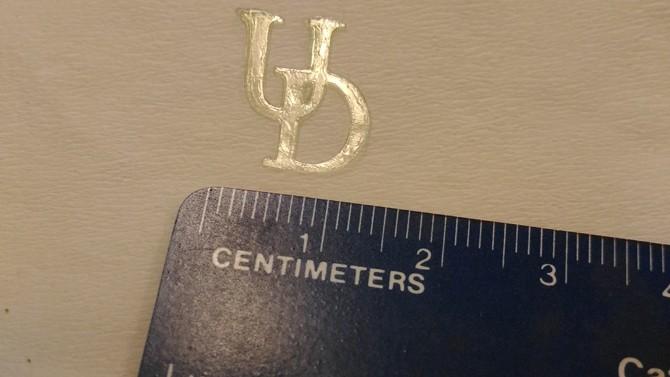Engineering on a blue streak

University of Delaware researchers made the University logo using their newly developed polymerization technique. Credit: Abhishek Shete/ University of Delaware
A pair of engineers at the University of Delaware has developed a process to form interwoven polymer networks more easily, quickly and sustainably than traditional methods allow. Their secret ingredient? Blue light.
Abhishek Shete, graduate research assistant in materials science and engineering, and Christopher Kloxin, assistant professor in materials science and engineering and chemical and biomolecular engineering, describe their method in a paper featured on the cover of the 24th issue of Polymer Chemistry. The paper is titled “One-pot blue-light triggered tough interpenetrating polymeric network (IPN) using CuAAC and methacrylate reactions.”
Polymers, which are materials made from chains of molecules, are found in everything from food to clothing to cars. Two or more types of polymer chains with different individual properties can also be linked together to form interpenetrating polymeric networks, materials that often combine favorable mechanical properties from each polymer such as high strength and toughness.
“These chemistries independently are used in a broad range of applications,” from dental composites, automobile bumpers to drug delivery materials, Shete said.
However, the process of linking polymers is not simple. It requires two chemical reactions, which are typically initiated through either a lengthy two-step process or a one-step process induced at elevated temperatures and longer time spans.
The method Kloxin and Shete developed is one step and works rapidly at room temperature and ambient conditions.
They use 470-nanometer blue light, which is similar to blue LED light used to detect certain body fluids in crime scene investigations. This light triggers reactions with a photosensitizer called camphorquinone and an activator called amine. These materials are commonly utilized in polymeric dental composites for filling cavities.
The light irradiates the materials to photostimulate the two chemical reactions, but not simultaneously. First up is a reaction called the copper-catalyzed azide-alkyne cycloaddition (CuAAC) click polymerization. This reaction is facilitated by copper, and polymerization occurs in steps. Next is a reaction called the methacrylate polymerization, which forms a plastic-like material in a manner similar to adding links to a growing chain. “This is unique in the way the blue light induces sequential reactions,” says Kloxin.
The end result is a material that Kloxin and Shete describe as a “glassy film,” less brittle than pure methacrylate and stronger than pure CuAAC at higher temperature. The films made from this IPN material also exhibit shape memory– when deformed, it can be returned to its original size and shape with 15 minutes of heating at 80 degrees Celsius.
This blue-light approach to form interpenetrating polymer networks saves time and energy, but those are not its only advantages. For one, this approach allows Kloxin and Shete to control the pair of chemical reactions with increased precision, allowing them to fashion the polymer networks into complex shapes. This rapid method also keeps the ingredients from separating in a way that could otherwise interfere with the formation of an interpenetrating polymer network.
In addition, the new process requires none of the solvents or additives commonly used in plastics manufacturing, often added to prevent brittle fracture. The materials reported by Kloxin and Shete exhibit enhanced toughness that overcomes this brittleness without any solvents or additives, also making it a greener synthetic approach.
The team has filed a provisional patent for the method described in the new paper. “These chemistries could be attached to other molecules,” Kloxin said, and the team will test their applications to form hydrogels, dental materials and other polymer networks.
Media Contact
All latest news from the category: Materials Sciences
Materials management deals with the research, development, manufacturing and processing of raw and industrial materials. Key aspects here are biological and medical issues, which play an increasingly important role in this field.
innovations-report offers in-depth articles related to the development and application of materials and the structure and properties of new materials.
Newest articles

Silicon Carbide Innovation Alliance to drive industrial-scale semiconductor work
Known for its ability to withstand extreme environments and high voltages, silicon carbide (SiC) is a semiconducting material made up of silicon and carbon atoms arranged into crystals that is…

New SPECT/CT technique shows impressive biomarker identification
…offers increased access for prostate cancer patients. A novel SPECT/CT acquisition method can accurately detect radiopharmaceutical biodistribution in a convenient manner for prostate cancer patients, opening the door for more…

How 3D printers can give robots a soft touch
Soft skin coverings and touch sensors have emerged as a promising feature for robots that are both safer and more intuitive for human interaction, but they are expensive and difficult…





















